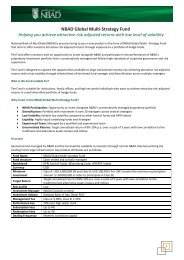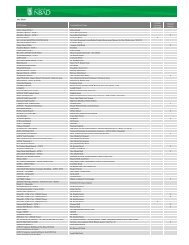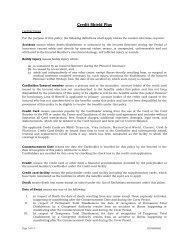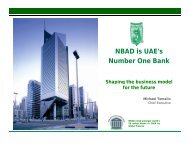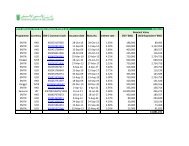English Version - National Bank of Abu Dhabi
English Version - National Bank of Abu Dhabi
English Version - National Bank of Abu Dhabi
You also want an ePaper? Increase the reach of your titles
YUMPU automatically turns print PDFs into web optimized ePapers that Google loves.
Notes to the consolidated financial statements<br />
Notes to the consolidated financial statements<br />
4 Financial risk management (continued) 4 Financial risk management (continued)<br />
Board Committees:<br />
a) Risk Management Committee (RMC), comprising<br />
members from the Board, is responsible for<br />
recommending and setting the Group’s risk strategy and<br />
policy guidelines, and thereafter monitor and adherence.<br />
The RMC is also set-up to monitor the Group’s credit,<br />
operational and market risks, to take credit decisions<br />
above management’s discretionary powers and to set<br />
market risk limits under which the Group’s management<br />
operates.<br />
b) Audit Committee (AC) is responsible for monitoring<br />
compliance with the Group’s risk management policies<br />
and procedures, and for reviewing the adequacy <strong>of</strong> the<br />
risk management framework. The Group AC is assisted<br />
in these functions by the Audit and Compliance Division.<br />
Management committees:<br />
The Risk Management Committee is set up as follows:<br />
i) Assets and Liabilities Committee (ALCO);<br />
ii) Group Credit Committee (GCC); and<br />
iii) Operational Risk Management Committee<br />
(ORMC).<br />
The execution responsibilities are delegated to the<br />
management committees, which are responsible for<br />
implementing the risk management framework. The<br />
major function <strong>of</strong> the three management committees is<br />
given below:<br />
i) Assets and Liabilities Committee (ALCO): The principle<br />
aim <strong>of</strong> ALCO is to achieve sustainable and stable pr<strong>of</strong>its<br />
within a framework <strong>of</strong> acceptable financial risks, which<br />
includes liquidity risk, interest rate risk, foreign exchange<br />
risk and capital management.<br />
ii) Group Credit Committee (GCC) is responsible for<br />
approving credit proposals under authority delegated<br />
by the Board. Credit proposals exceeding the authority<br />
<strong>of</strong> the GCC are referred to the RMC. The GCC also<br />
recommends credit policy and strategy issues and<br />
periodically monitors the credit portfolio <strong>of</strong> the Group.<br />
The provisioning for the assets also forms part <strong>of</strong> the<br />
GCC function. The GCC in turn delegates authority to<br />
divisional credit committees.<br />
iii) Operational Risk Management Committee (ORMC):<br />
The primary objective <strong>of</strong> ORMC is to steer and align<br />
the operational risk management activities in the<br />
<strong>Bank</strong>. ORMC acts as the central point in co-ordinating<br />
various efforts and initiatives that relate to operational<br />
risk management including alignment with other<br />
operational risk mitigating strategies such as Business<br />
Continuity Management, Information Securities, Anti<br />
Money Laundering, Process improvement, Internal<br />
Audit. The ORMC is the main source <strong>of</strong> operational risk<br />
management input for RMC.<br />
A separate Risk Management Division (RMD), reporting<br />
to the Risk Management Committee, assists in carrying<br />
out the oversight responsibility <strong>of</strong> the Board. There are<br />
three main independent functions <strong>of</strong> the RMD, which<br />
are: (i) Credit Underwriting; (ii) Credit Administration<br />
and (iii) Independent Portfolio Risk Management. The<br />
Credit underwriting function deals with independent<br />
underwriting <strong>of</strong> domestic, international and remedial<br />
advances. There is clear segregation between the<br />
credit approval and independent risk management,<br />
with a middle <strong>of</strong>fice straddling between the two areas,<br />
to provide logistical support from an administrative,<br />
systems and compliance perspective.<br />
All risk management policies are reviewed and approved<br />
regularly by the relevant committee <strong>of</strong> the Board and /<br />
or management to reflect changes in market conditions,<br />
products and services <strong>of</strong>fered.<br />
(b) Credit risk<br />
Credit risk is the risk that a customer or counterparty to<br />
a financial asset fails to meet its contractual obligations<br />
and cause the Group to incur a financial loss. It arises<br />
principally from the Group’s loans and advances, due<br />
from banks and non-trading investments.<br />
For risk management purposes, credit risk arising on<br />
trading investments is managed independently, and<br />
reported as a component <strong>of</strong> market risk exposure.<br />
Management <strong>of</strong> credit risk<br />
The Group’s credit risk management framework<br />
includes:<br />
• Establishment <strong>of</strong> authorisation structure and limits for<br />
the approval and renewal <strong>of</strong> credit facilities;<br />
• Reviewing and assessing credit exposures in<br />
accordance with authorisation structure and limits,<br />
prior to facilities being committed to customers.<br />
Renewals and reviews <strong>of</strong> facilities are subject to the<br />
same review process;<br />
• Diversification <strong>of</strong> lending and investment activities;<br />
• Limiting concentrations <strong>of</strong> exposure to industry sectors,<br />
geographic locations and counterparties; and<br />
• Reviewing compliance, on an ongoing basis, with<br />
agreed exposure limits relating to counterparties,<br />
industries and countries and reviewing limits in<br />
accordance with risk management strategy and market<br />
trends.<br />
The RMC is responsible for sanctioning high value credits<br />
and the Group Credit Committee is responsible for the<br />
formulation <strong>of</strong> credit policies and processes in line with<br />
growth, risk management and strategic objectives.<br />
The Group uses an internal risk rating system to assess<br />
the credit quality <strong>of</strong> borrowers and counterparties. Each<br />
exposure in the Sovereign, <strong>Bank</strong>s and Corporate asset<br />
classes is assigned a rating. The risk rating system has<br />
11 grades, further segregated into 24 notches. Grades<br />
1-7 are performing, Grade 8 is Other Loans Especially<br />
Mentioned (OLEM) and Grades 9 -11 are non –<br />
performing each with a rating description.<br />
• For Sovereign and <strong>Bank</strong>s, rating grades are mapped<br />
to Long-Term External Credit Assessment Agency<br />
Ratings.<br />
• For Corporate, these are mapped to an Internal Rating<br />
Based (IRB) expert system, tuned for GCC conditions.<br />
• Each grade in the rating system is linked to a statistical<br />
Probability <strong>of</strong> Default (PD).<br />
The risk rating system plays a significant role in efficient<br />
use <strong>of</strong> credit risk measurement and management<br />
including:<br />
• Risk based pricing and determination <strong>of</strong> Risk adjusted<br />
return on capital<br />
• Risk based monitoring (Frequency and intensity <strong>of</strong><br />
monitoring)<br />
• Determining risk based delegation <strong>of</strong> powers at various<br />
sanction authority levels<br />
• Impairment testing<br />
• In due course the rating is also designed towards<br />
estimation <strong>of</strong> regulatory capital as per Basel II<br />
The rating system is subject to annual review and<br />
verification process.<br />
Retail lending business is governed by the product<br />
programs vetted by the risk management department and<br />
employs credit scoring technique to process small scale,<br />
large volume credit decisions. The scores are combined<br />
with management judgement to ensure effective ongoing<br />
process <strong>of</strong> approval, review and enhancement.<br />
Credit risk monitoring is performed at various levels:<br />
i) Monitoring <strong>of</strong> risk quality (Obligor level): The Group<br />
has a process for risk rating review relative to initial<br />
rating grade bands. More frequent reviews are made<br />
for the poorer credits and less frequent reviews for the<br />
superior credits. The Group has a process <strong>of</strong> defining<br />
and reporting all the potential problem account.<br />
ii) Monitoring <strong>of</strong> risk quality (Portfolio Level): Group<br />
monitors the existing portfolio based on the economic<br />
sectors, industry, geography, ratings and business lines.<br />
These portfolio reports are generated periodically and<br />
senior management is informed <strong>of</strong> the same.<br />
iii) Monitoring <strong>of</strong> past dues on principal and interest: All the<br />
past dues on principal and interest on loans and advances<br />
portfolio <strong>of</strong> the Group are reported periodically to the<br />
senior management. Measures to realise the accounts<br />
are initiated and close follow up is done.<br />
iv) Monitoring <strong>of</strong> excess over limits: Group has a policy<br />
<strong>of</strong> monitoring all excesses over limits. The monitoring<br />
reports are submitted to the senior management and<br />
processes are initiated to realise the accounts.<br />
v) Monitoring <strong>of</strong> potential loss accounts (OLEM): This<br />
category comprises <strong>of</strong> accounts where principal or<br />
interest are past due for more than 30 days or accounts<br />
which show some potential weakness in the borrower’s<br />
financial position and credit worthiness, which requires<br />
greater follow-up and monitoring.<br />
In addition, the Group manages the credit exposure<br />
by obtaining security where appropriate and limiting<br />
the duration <strong>of</strong> exposure. In certain cases, the Group<br />
may also close out transactions or assign them to other<br />
counterparties to mitigate credit risk. Credit risk in<br />
respect <strong>of</strong> derivative financial instruments is limited to<br />
those with positive fair values.<br />
Regular audits <strong>of</strong> business units and Group credit<br />
processes are undertaken by Internal Audit and<br />
Compliance Division.<br />
57





